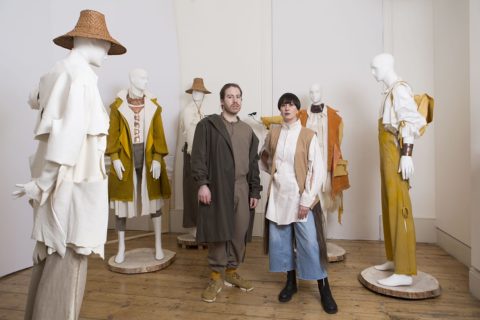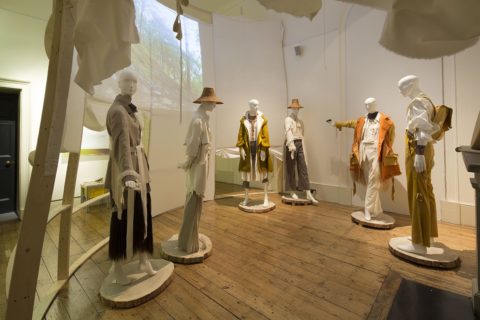Designer Curtis Oland is Bringing Indigenous Fashion to London (and Beyond)
He’s gone from Ryerson University in Toronto to presenting his designs at the International Fashion Showcase at London Fashion Week.
Addressing the group of 16 young designers assembled at London’s historic Somerset House for the culmination of this year’s International Fashion Showcase (a joint effort by the British Fashion Council, British Council and London College of Fashion to support nascent talent around the world), Sarah Mower, BFC’s Ambassador for Emerging Talent, said: “You’re change-makers and activists and you will improve our industry. I’m certain you are the future.”
Part of that hopeful future is Curtis Oland, a Canadian designer of Lil’Wat heritage who grew up in the Okanagan Valley in British Columbia. Oland studied fine art with a concentration in sculpture from Emily Carr University in Vancouver, which is where he also got interested in costume history and textiles, began watching fashion television, and discovered Alexander McQueen. “I realized fashion could be sculptural, and a medium of expression,” he says.
“I realized fashion could be sculptural, and a medium of expression,” he says.
So he went on to enrol in a fashion design program at Ryerson University, winning a menswear competition for emerging designers as a young graduate and starting his eponymous brand. As a designer fresh out of grad school, though, Oland found the Canadian market “quite conservative” for him at a time when he was experimenting and still trying to find his voice as a designer. He decided to move to London to get some experience, landing an internship at Savile Row where he went on to become assistant designer. Soon Indigenous Fashion Week Toronto (IFWTO) reached out to him for a project, eventually nominating him for the International Fashion Showcase, for which he revived his own brand.

“We’d been working with the British Council since before we started this project and they really encouraged us to put forth some nominations for IFS,” explains Sage Paul, founder of IFWTO, and producer of Delicate Tissue, the collection/installation Oland presented at IFS. “So we put forth three from Canada, one of them being Curtis, who came on my radar a number of years ago—through a mutual colleague— as an indigenous designer doing incredible work. The conceptual process that he takes to create his work, I really appreciate and value, and the fact that he’s making clothing rooted in culture and the land that he comes from.”
London-based since 2017, the Ryerson grad draws on his Lil’wat heritage to create thoughtful pieces from raw materials like organic cotton, wool, silk and linen as well as deer and elk skins, materials traditionally used by the Lil’wat people. He presented his AW19 collection at Somerset House as a collaborative multimedia project involving film and music, bringing together the talents of various indigenous artists from Canada, including filmmakers Nyla Innuksuk and her partner Ksenia Stassiouk, performance artist Jeneen Frei Njootli, Anishinaabe sound artist Ziibiwan Mahgagahbow, Cree cellist and composer Cris Derksen, and Tuscarora singer Jennifer Kreisberg.
“The film is a collage of various kinds of footage captured in the natural environments in my home province of British Columbia,” explains Oland. “Footage was taken around the Okanagan territory, on Squamish territory along the Capilano River, and Lil’Wat territory in Mount Currie.”
The goal of this collaborative project, says Oland, was to convey that while different indigenous nations are united by common values and a shared belief system, they each have a distinct identity that is often perceived as homogenous.
“When I came over here, I realized people’s understanding of what it means to be an indigenous Canadian came with preconceived notions,” he says. “So what we wanted to get across [with this project] is that we worked as a collective of artists in various mediums but we each come from a different tribal nation in Canada. So on the one hand we want to challenge the notion of a homogenized indigenous culture because we are vastly different in all aspects but at the same time, we do unite under a very similar ethos and that is our connection to land and our relationship to nature.”

Oland hopes that starting conversations about the varied experiences of diverse indigenous nations through something like his installation at the International Fashion Showcase will encourage others to really listen to each other’s stories. “Hopefully this will encourage others to seek out and work with other artists and designers, and foster a bit of cultural exchange between us because a lot of people are afraid of cultural appropriation, and [want to know] ‘how am I allowed to participate’ and ‘where is the line drawn.’ We can only help figure that out if we all start talking about it.”
At the heart of indigenous fashion is honouring the raw, natural state of materials, something that features heavily in Oland’s work. “We don’t want to hyper process anything, we want to let the material live in its own nature,” he explains. “The leather, for example—we use the edges of the hide, which normally would be cut off and discarded but there’s something very beautiful to that organic, raw aesthetic.” He often leaves edges frayed, threads and strands of fabric gently dropping off with time.
At the heart of indigenous fashion is honouring the raw, natural state of materials, something that features heavily in Oland’s work.
“I want to highlight the fact that clothing doesn’t last forever, it’s a living thing,” he says. “It kind of has its own essence, its own spirit, so I allow it to become what it will become. There’s only so much I can control.”

Ceding control seems to be something Oland is comfortable with. At the moment, he’s in a period of transition, one in which he’s taking the time to re-interpret his brand in a way that best reflects his inner dialogue.
“I want to be part of a change in the industry,” says Oland. “I’m being cautious of everything; so I’m playing with my aesthetic and figuring out what I’m trying to say and show.”
For now, his focus is on collaborations and event-based projects as opposed to adhering to a rigid fashion calendar. It’s rebellious, he admits, but it’s what feels right for his brand. Figuring out where he fits into the fashion space is an ongoing process but Oland knows he wants to create garments that are part-performative and part-costume, that have some sort of deeper subtext. So what led to this desire to create garments with a purpose beyond mere wearability?
“My fear of consumerism,” he laughs. “I’m trying to create a message, talk about garments that people can feel a connection to. Creating garments is an intimate process. I want them to be a part of a longer story, a longer life.”








